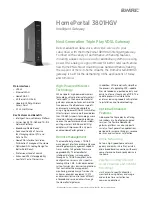
Glossary
FRITZ!Box Fon WLAN 7113
111
is grouped into address classes designated as A, B, C, D
and E. Only the first three of these five address classes are
actually used. These classes can be described as follows:
Properties of IP Address Classes
Every IP address consists of two parts: the network
address and the host address. The sizes of the network
address and the host address are variable, and
determined by the first four bits (of the first byte) of the IP
address.
IP
masquerading
By means of IP masquerading a computer or LAN can be
protected from unauthorized connection request from the
Internet. Masquerading works by converting the IP
addresses used in a network to one public IP address.
From the outside it appears that all requests are sent from
a single computer.
IP network
A network in which data exchange takes place on the
basis of the Internet Protocol is called an IP network.
outside dialing
prefix
The Outside Dialing Prefix is the digit dialed at an
extension line to obtain an outside line. Generally this is
“0”.
port
So that a single network connection on a PC can be used
by multiple applications to exchange data with remote
sites at the same time, a PC administers what are known
as ports for the IP-based protocols TCP and UDP. Ports
substantiate the point of access for the data packets
delivered via the IP Internet protocol. While the IP address
Classes
Properties
Network address
Decimal value
Class A
address
few networks, many hubs
0-127
Class B
address
intermediate distribution of
networks and hubs
128-191
Class C
address
many networks, few hubs
192-223












































